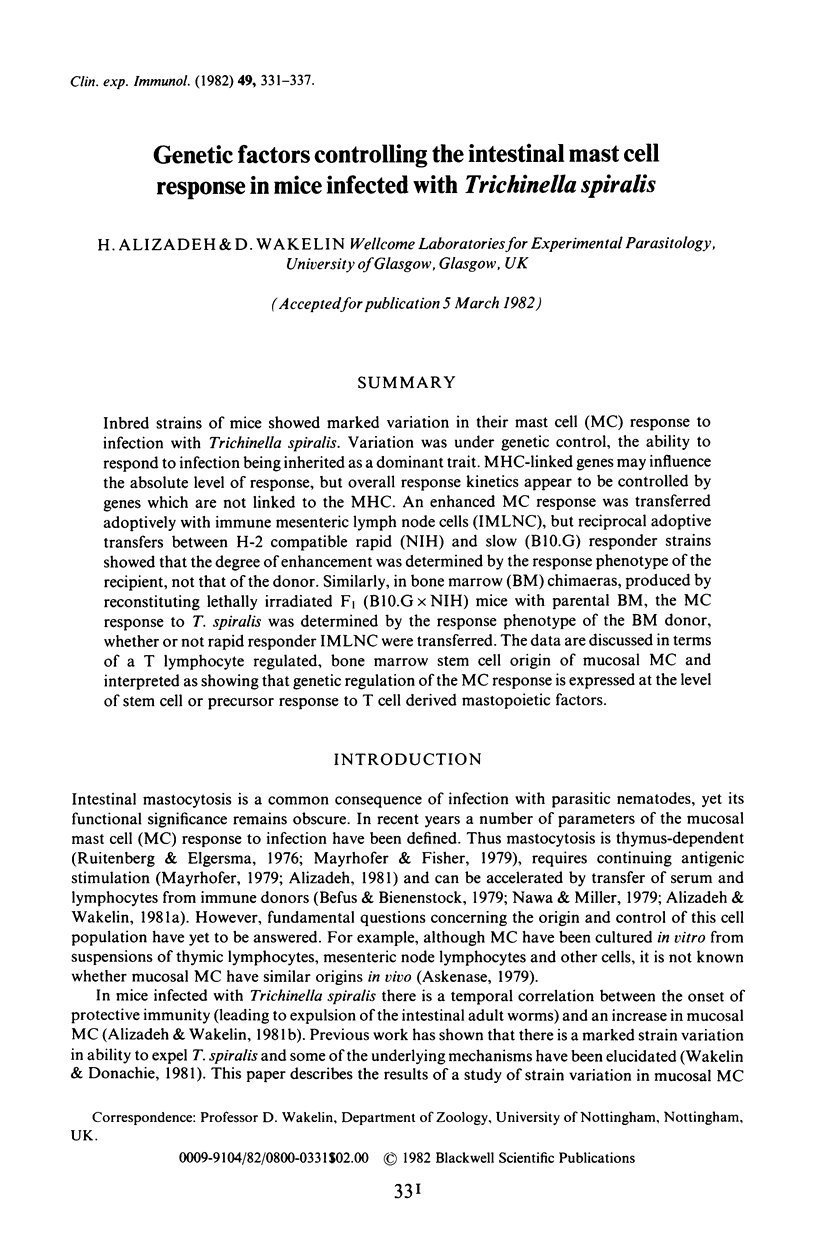Genetic factors controlling the intestinal mast cell response in mice infected with Trichinella spiralis (original) (raw)
. 1982 Aug;49(2):331–337.
Abstract
Inbred strains of mice showed marked variation in their mast cell (MC) response to infection with Trichinella spiralis. Variation was under genetic control, the ability to respond to infection being inherited as a dominant trait. MHC-linked genes may influence the absolute level of response, but overall response kinetics appear to be controlled by genes which are not linked to the MHC. An enhanced MC response was transferred adoptively with immune mesenteric lymph node cells (IMLNC), but reciprocal adoptive transfers between H-2 compatible rapid (NIH) and slow (B10.G) responder strains showed that the degree of enhancement was determined by the response phenotype of the recipient, not that of the donor. Similarly, in bone marrow (BM) chimaeras, produced by reconstituting lethally irradiated F1 (B10.G x NIH) mice with parental BM, the MC response to T. spiralis was determined by the response phenotype of the BM donor, whether or not rapid responder IMLNC were transferred. The data are discussed in terms of a T lymphocyte regulated, bone marrow stem cell origin of mucosal MC and interpreted as showing that genetic regulation of the MC response is expressed at the level of stem cell or precursor response to T cell derived mastopoietic factors.

Selected References
These references are in PubMed. This may not be the complete list of references from this article.
- Denburg J. A., Befus A. D., Bienenstock J. Growth and differentiation in vitro of mast cells from mesenteric lymph nodes of Nippostrongylus brasiliensis-infected rats. Immunology. 1980 Sep;41(1):195–202. [PMC free article] [PubMed] [Google Scholar]
- Kitamura Y., Go S., Hatanaka K. Decrease of mast cells in W/Wv mice and their increase by bone marrow transplantation. Blood. 1978 Aug;52(2):447–452. [PubMed] [Google Scholar]
- Mayrhofer G., Fisher R. Mast cells in severely T-cell depleted rats and the response to infestation with Nippostrongylus brasiliensis. Immunology. 1979 May;37(1):145–155. [PMC free article] [PubMed] [Google Scholar]
- Mayrhofer G. The nature of the thymus dependency of mucosal mast cells. I. An adaptive secondary response to challenge with Nippostrongylus brasiliensis. Cell Immunol. 1979 Oct;47(2):304–311. doi: 10.1016/0008-8749(79)90340-x. [DOI] [PubMed] [Google Scholar]
- Nabel G., Galli S. J., Dvorak A. M., Dvorak H. F., Cantor H. Inducer T lymphocytes synthesize a factor that stimulates proliferation of cloned mast cells. Nature. 1981 May 28;291(5813):332–334. doi: 10.1038/291332a0. [DOI] [PubMed] [Google Scholar]
- Nagao K., Yokoro K., Aaronson S. A. Continuous lines of basophil/mast cells derived from normal mouse bone marrow. Science. 1981 Apr 17;212(4492):333–335. doi: 10.1126/science.7209531. [DOI] [PubMed] [Google Scholar]
- Nawa Y., Miller H. R. Adoptive transfer of the intestinal mast cell response in rats infected with Nippostrongylus brasiliensis. Cell Immunol. 1979 Feb;42(2):225–239. doi: 10.1016/0008-8749(79)90188-6. [DOI] [PubMed] [Google Scholar]
- Ruitenberg E. J., Elgersma A. Absence of intestinal mast cell response in congenitally athymic mice during Trichinella spiralis infection. Nature. 1976 Nov 18;264(5583):258–260. doi: 10.1038/264258a0. [DOI] [PubMed] [Google Scholar]
- Ruitenberg E. J., Perrudet-Badoux A., Boussac-Aron Y., Elgersma A. Trichinella spiralis infection in animals genetically selected for high and low antibody production. Studies on intestinal pathology. Int Arch Allergy Appl Immunol. 1980;62(1):104–110. doi: 10.1159/000232500. [DOI] [PubMed] [Google Scholar]
- Ruscetti F. W., Cypess R. H., Chervenick P. A. Specific release of neutrophillic- and eosinophilic-stimulating factors from sensitized lymphocytes. Blood. 1976 May;47(5):757–765. [PubMed] [Google Scholar]
- Schrader J. W. In in vitro production and cloning of the P cell, a bone marrow-derived null cell that expresses H-2 and Ia-antigens, has mast cell-like granules, and is regulated by a factor released by activated T cells. J Immunol. 1981 Feb;126(2):452–458. [PubMed] [Google Scholar]
- Wakelin D., Donachie A. M. Genetic control of immunity to Trichinella spiralis. Donor bone marrow cells determine responses to infection in mouse radiation chimaeras. Immunology. 1981 Aug;43(4):787–792. [PMC free article] [PubMed] [Google Scholar]
- Wakelin D., Donachie A. M. Genetic control of immunity to parasites: adoptive transfer of immunity between inbred strains of mice characterized by rapid and slow immune expulsion of Trichinella spiralis. Parasite Immunol. 1980 Winter;2(4):249–260. doi: 10.1111/j.1365-3024.1980.tb00057.x. [DOI] [PubMed] [Google Scholar]
- Wakelin D., Lloyd M. Immunity to primary and challenge infections of Trichinella spiralis in mice: a re-examination of conventional parameters. Parasitology. 1976 Apr;72(2):173–182. doi: 10.1017/s0031182000048472. [DOI] [PubMed] [Google Scholar]
- Wakelin D., Wilson M. M. Immunity to Trichinella spiralis in irradiated mice. Int J Parasitol. 1980 Feb;10(1):37–41. doi: 10.1016/0020-7519(80)90062-4. [DOI] [PubMed] [Google Scholar]
- Wakelin D., Wilson M. M. Transfer of immunity to Trichinella spiralis in the mouse with mesenteric lymph node cells: time of appearance of effective cells in donors and expression of immunity in recipients. Parasitology. 1977 Jun;74(3):215–224. doi: 10.1017/s0031182000047843. [DOI] [PubMed] [Google Scholar]